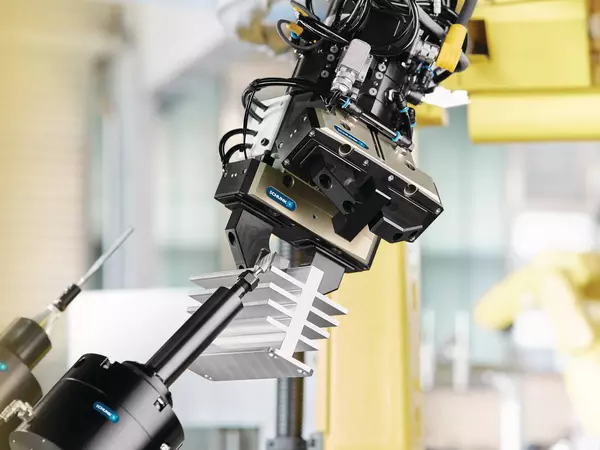


In surface processing, the characteristics of surfaces are modified, refined, and optimized to meet defined requirements. The work required for this is often still done manually. There are several reasons why many companies are hesitant to switch to automated methods. Human vision and feeling is often considered irreplaceable and more precise compared to the "insensitive" machine. The challenges associated with the automating machining processes also seem too great. Companies that work with a large variety of parts and complex workpiece geometries fear a high level of effort in programming the robot and integrating it into existing processes. Particularly in the case of fine machining, the prevailing opinion is that automation can only be implemented at a very high cost. After all, until now there was a lack of detailed knowledge about the parameters of a deburring or grinding process as well as of universally applicable standard solutions.
Nevertheless, there are many arguments in favor of using "co-worker robot" for the machining of workpieces in the future. The manual precision work on the workpiece is often stressful for the employees or even hazardous to their health, e.g. due to particle emissions such as abrasive dust or chips. These risks can be minimized by switching to automated processing methods. The safety and also the ergonomics of the workplace are significantly improved. From a business perspective, processes must also be constantly optimized and unit costs reduced. The use of the robot in machining offers significant competitive advantages here: The processing time is shortened and the machining capacity is increased. In addition, the demands on the market are increasing and consistently flawless products are required. Consistently high quality of the work results is reliably ensured by means of robot-assisted processing. Shorter product cycles and the increasing pace of innovation also require more flexibility – a requirement that the robot meets perfectly. Users who already use automated methods have a clear advantage in view of these trends. The fact that the interest in and demand for solutions for automated machining are increasing is the logical consequence.

Robots can do both: loading and machining. Here lies a great, as yet rarely recognized and underutilized potential, because many advantages can also be achieved with automated processes during machining: Companies that already use a robot for loading and unloading their machine tool can also use it for deburring the workpieces and therefore make much better use of its capacity. This is made possible by the new SCHUNK tools for automated machining. Due to the different functionalities and the outstanding features of the products, numerous deburring tasks can be automated and thus take place directly after machining in the machine tool. The machine tool can continue to produce at the same time. Throughput time and production costs of the workpieces can be significantly reduced in this way – with a comparatively low investment volume and a fast return on investment.
Users from various industries can profit from the advantages. Clean deburring is particularly necessary for metalworking and in case of plastic parts, as sharp edges can occur here. High-quality results are also essential when grinding workpieces such as metal housings and wooden components, and when polishing workpiece surfaces in the automotive and aerospace industries. With these different applications in mind, SCHUNK has specifically expanded its portfolio – beyond the previous tools FDB, FDB-AC, and MFT. The right solution for any application. The range includes pneumatic components with axial or radial compensation for deburring, grinding, and polishing. SCHUNK offers a versatile selection for all forms of reworking, particularly with deburring tools,

Grinding of workpieces is often used when surfaces need to be prepared for downstream finishing operations. For example, if a workpiece is to be painted or galvanized, the surface must be uniform and finely structured. Therefore, any defects, grinding marks, or roughness from previous operations must be eliminated by grinding. With the right choice of tools and abrasives, different materials such as metal, wood, or plastic can be processed with different material removal rates and surface finishes.
Performed by hand, grinding poses injury and health risks to employees. The pneumatic orbital sander AOV with axial compensation avoids these dangers and achieves perfect sanding results. The AOV is driven by a vane motor with a bidirectional (retraction/extension) controllable contact force of 6.7 N to 67 N. Due to the compensation, the contact force can always be kept constant regardless of the orientation of the tool. The optional connection for the suction of the removed material significantly reduces contamination and susceptibility to faults. The tool can be used with proven, adhesive grinding, and polishing discs and optionally with two different grinding disc diameters. These characteristics increase the flexibility, so that the AOV can also prove its qualities during polishing.

With the right tools, the way is clear for automating the process. To ensure that the correct result is achieved with the robot application, each application can be validated in the new SCHUNK CoLab. In addition, experienced application engineers provide support in working out the optimal process parameters for the grinding or polishing solution. The guarantee for optimal results.
More efficiency and flexibility with little effort and manageable costs: This is how profitable the changeover to automated processes can be. With the expanded end-of-arm portfolio, SCHUNK now also offers customers a comprehensive range for robotic material removal, with which these advantages can be realized.